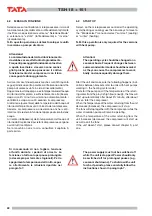
28
TSH 18 ÷ 151
1. Give off idraulic circuit, verify the right running of pumps and if valves are open
2. Check the phase sequence, check the voltage and close the con tacts.
3. See point II.
4. Check the water circulation pump and the differential water pressure
switch, and vent the circuit. Check further external enables.
5. System on temperature, no cooling demand. Check adjustment and operation.
6. Check adjustment and operation.
7. See points IV or V.
8. Wait for about 5 minutes.
9. See point VI.
1. Replace.
2. Close the compressor circuit breaker after identifying the reason why it
cut
in.
3. The compressor was working in critical con di tions or there isn't enough
refrigerant. Check the work conditions and see point VII.
4. Check the voltage at the ends of the contactor coil and the continuity of
the coil.Replace if faulty.
1. Check and replace if necessary.
2. See point V.
3. Check and replace if necessary.
4. Modify them by referring to the information shown on the microprocessor
programme.
5. See point VII.
1. Check and replace.
2. Remove the excess refrigerant liquid from the system.
3. Drain the circuit, pressurise and recharge the unit
4. Check and replace.
5. Clean the fi lters with compressed air or water.
6. See point VI.
7. Vent the water circuit.
8. Check the pump and replace if necessary.
1. Check and replace.
2. See point VII.
3. Check, clean and replace if necessary.
4. Check and replace.
5. Clean the fi lters with compressed air or water.
6. See point VI.
7. See point XIII.
8. Check the pump and replace if necessary
1. No fl ow-switch or differential pressure switch agreement
2. The connections are faulty or the con tacts are open
3. The compressor's faulty
4. The external enables have not been given
5. The work probe enable has not been given
6. The antifreeze enable has not been given (+)
7. A safety device enable has not been given (+)
8. The anti-recirculation timer is active
9. The fan thermal cut-outs trip (+)
1. The compressor has blown
2. The power circuit is open
3. The motor protection is open (+)
4. The compressor contactor is disabled
1. The compressor's faulty
2. The low pressure switch has cut in (+)
3. The compressor contactor is faulty
4. The set-point values are incorrectly set
5. There's not enough refrigerant liquid
1. The pressure switch doesn't work
2. There's too much refrigerant liquid
3. There's non condensable gas in the refrigerant circuit
4. The refrigerant fi lter is clogged
5. The metal fi lters of the condenser (if fi tted) are clogged.
The air fl ow is too low *
6. The condenser fans do not work *
7. There's air in the water circuit **
8. The circulation pump is faulty **
1. The pressure switch doesn't work
2. The unit is completely empty
3. The thermostatic expansion valve doesn't work properly
4. The refrigerant fi lter is clogged
5. The metal fi lters of the evaporator (if fi tted) are
clogged. The air fl ow is too low **
6. The evaporator fans do not work **
7. The evaporating coil is covered with frost **
8. The water circulation pump is faulty *
I.
THE UNIT
DOESN'T START
II.
A COMPRESSOR
DOESN'T START
III.
THE
COMPRESSOR
STARTS AND
STOPS
REPEATEDLY
IV.
A COMPRESSOR
DOESN'T START
BECAUSE THE
HIGH PRES SU RE
SWITCH HAS CUT
IN (+)
V.
A COMPRESSOR
DOESN'T START
BECAUSE THE
LOW PRES SU RE
SWITCH HAS CUT
IN (+)
PROBLEM
POSSIBLE
REASONS
RECOMMENDED
AC
TION
(+) The microprocessor indicates when the safety devices cut
in (see attached manual).
* Operation only during cooling cycle.
** Operation only during heating cycle.
8 TROUBLE
SHOOTING





































